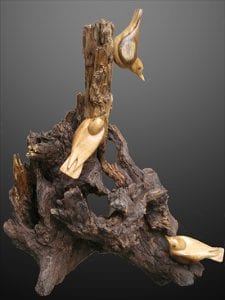
American chestnut wood and its root are represented in this carving by Gary, titled “Nuthatch Antics.”
When people see my work, they usually ask me about the woods I use for carving. They want to know which wood is my favorite. I tell them my favorite is American chestnut wood. I also tell them that a person must be crazy to carve American chestnut. That elicits a quizzical look until I explain.
American chestnut wood is ring porous. Each annual ring has a layer of porous spring growth and a summer growth layer with few pores. That gives chestnut a beautiful grain pattern. But carving tools tend to dig into the porous layer and carving details in the porous layer is tricky if not foolhardy. Also, chestnut wood can split easily (think twenty-foot-long split rails for fencing). I have often had to reorient a bird head or glue a piece back on. Finally, recycled chestnut wood (or any other recycled wood) is non uniform. Some areas of an old beam are harder or softer, some are more brittle, and often there is internal insect damage.
So why do I carve chestnut wood? Because of its natural beauty and the challenge. Plus, American chestnut and its restoration is one of my passions.
Click here to read an article about Gary’s carvings that was published in a local MD newspaper. To see more of Gary’s carvings, visit his website.
